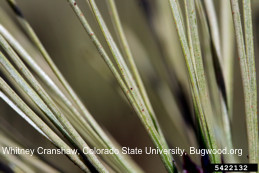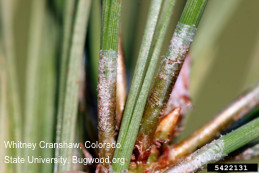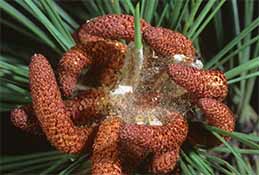Pine and spruce spider mites—Oligonychus spp.
Various species of mites (Tetranychidae) can cause conifer foliage to become discolored when they feed by sucking on the needles.
Identification
Oligonychus subnudus and O. milleri occur on pines, especially Monterey pine. The spruce spider mite, O. ununguis, can occur on virtually any conifer, including arborvitae, Chamaecyparis, coast redwood, Douglas-fir, fir, giant sequoia, juniper, spruce, and occasionally pine.
These tiny mites have an oval, unsegmented body. Depending in part on the host plant and mite species, these mites can be brown, green, or pink. The spruce spider mite produces webbing, especially around the base of needles; neither O. subnudus nor O. milleri produces obvious webbing.
Life cycle
Spider mites and the predatory mites (Phytoseiidae) that prey on them develop through five life stages. Eggs hatch, producing six-legged larvae. The two nymphal stages and adults have eight legs.
Spider mite populations are relatively low on conifers during the winter. Oligonychus subnudus is most abundant in the spring. Oligonychus milleri can be abundant anytime from spring through fall. Spruce spider mite is usually most abundant in the spring and fall, and populations stop reproducing under prolonged high temperatures.
Damage
Feeding by Oligonychus spp. mites causes conifer foliage to become bleached or discolored bronze, reddish, or yellow. Mite damage is usually not as serious as it looks. Most plants tolerate extensive leaf bleaching and stippling without being seriously harmed.
Solutions
The most important management actions are to conserve natural enemies of mites and provide trees with proper cultural care, especially appropriate irrigation to keep plants healthy. Drought-stressed plants experience more mite outbreaks and are less able to tolerate pest feeding. Regularly sprinkling foliage and washing plants during hot weather helps control some mites, in part by removing dust and improving the environment for predaceous mites.
High-levels of nitrogen in foliage can favor outbreaks of some mites by increasing their reproduction. Do not apply nitrogen unless fertilization is truly necessary. Avoid applying high rates of nitrogen and use less-soluble forms, such as urea and most organic fertilizers.
Natural enemies, especially predaceous mites, frequently control plant-feeding mites. Avoid using broad-spectrum, residual pesticides (e.g., carbamates, organophosphates, and pyrethroids) for mites or other pests. Even though their labels may say they control mites, these pesticides kill mite predators. Also, they can induce physiological changes in mites or host plants and, especially during hot weather, sometimes cause dramatic outbreaks of mites.
If spraying is warranted, use selective miticides (also called acaricides) or horticultural oil. Be aware that applying horticultural (narrow-range) oil can remove the desirable bluish cast on foliage of certain spruces; this does not damage tree health.
Feeding on young foliage may not produce obvious damage until months later, when foliage matures. Therefore, the effectiveness of any current treatment (e.g., thoroughly covering foliage with narrow-range, horticultural oil) may not become apparent until the following season. See Pest Notes: Spider Mites and Mites Associated with Pine Foliage in California for more information.
|

Needles bleached by mites

Spider mite eggs on needles

Spruce spider mite webbing
|


